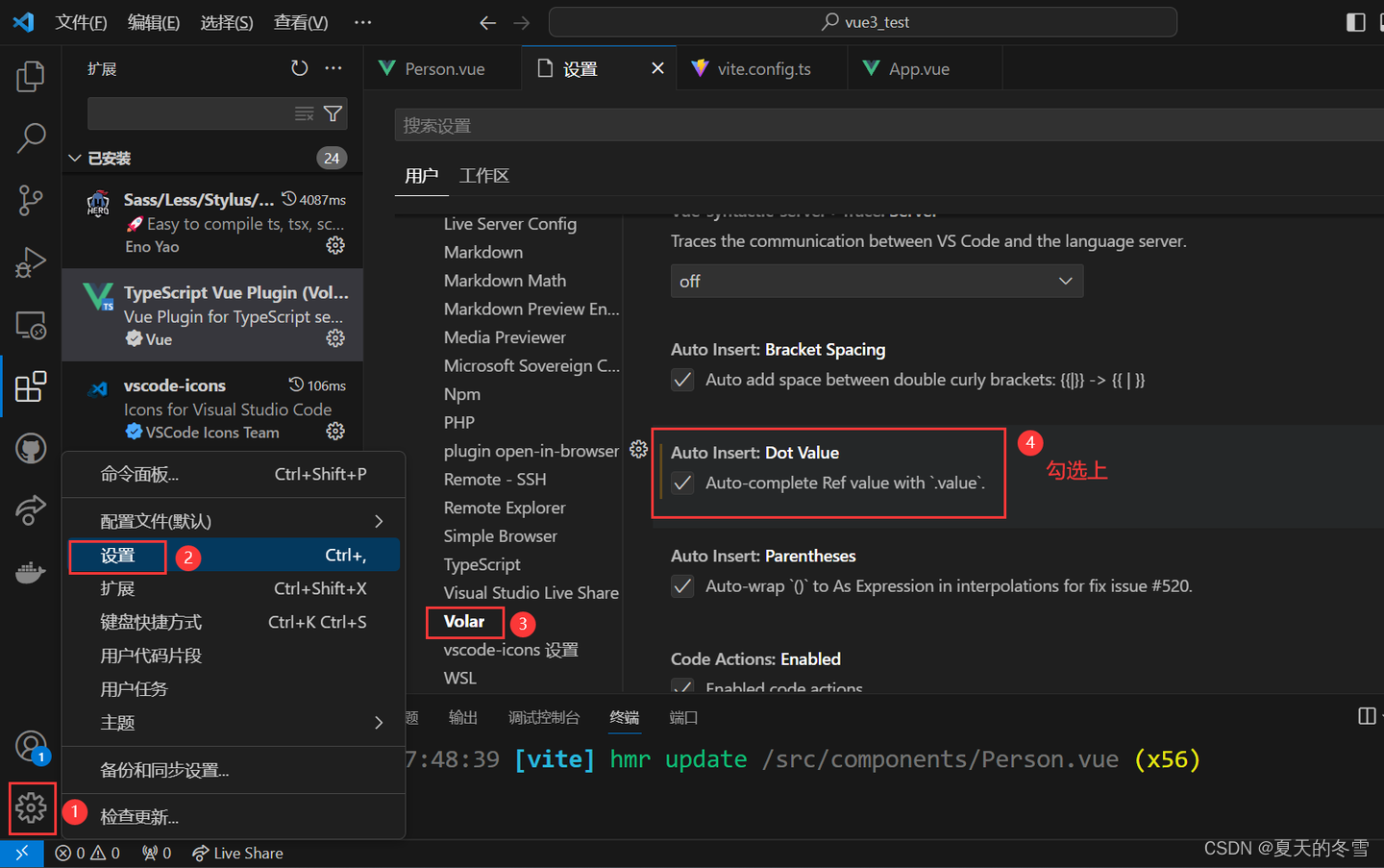Vue-响应式数据
2024-01-02 05:50:00
一、ref创建基本类型的响应式数据
vue3可以使用ref、reactive去定义响应式数数据。
知识点汇总
- 使用ref需要先引入ref,
import {ref} from 'vue' - 在模板
template中使用了添加ref的响应式数据,变量的后面不用添加.value - 所有js代码里面,去操作res包裹的东西,必须要加上
.value - 使用ref包裹的变量,都变成了对象,其中不带下划线的
value是提供我们自己使用的。 - ref可以定义基本类型、对象类型的响应式数据。


这个value中就是真正的变量数据。
Person.vue组件中的代码:
<template>
<div class="person">
<!-- 模板里面不用 name.value,自动帮你加上.value -->
<h2>姓名:{{name}}</h2>
<h2>年龄:{{age}}</h2>
<h2>地址:{{address}}</h2>
<button @click="changeName">修改名字</button>
<button @click="changeAge">增加年龄</button>
<button @click="showTel">查看联系方式</button>
</div>
</template>
<script setup lang="ts" name="Person">
//引入ref,所有js代码里面,去操作res包裹的东西,必须要加上 .value
import {ref} from 'vue'
//数据
let name = ref('张三') // 注意ref是函数
let age = ref(18)
let tel = 13888888888
let address = '河北 . 邯郸'
console.log(1,name)
console.log(2,age)
//方法
function changeName(){
name.value = 'zhang-san'
console.log(1,name.value)
}
function changeAge(){
age.value += 1
console.log(2,age.value)
}
function showTel(){
alert(tel)
}
</script>
<style scoped>
.person{
background-color: skyblue;
box-shadow: 0 0 10px;
border-radius: 10px;
padding: 20px;
}
button{
margin: 0 5px;
}
</style>
二、reactive创建对象类型的响应式数据
reactive用于定义对象类型的数据
知识点汇总:
- 使用reactive()可以把对象类型的数据变成响应式的。
- 数组也是对象,也可以使用reactive()去包裹数组。
- reactive定义的对象类型的响应式数据是深层次的。
- reactive只能定义对象类型的响应式数据。
<template>
<div class="person">
<h2>一辆{{car.brand}}价值{{car.price}}万</h2>
<button @click="changePrice">修改汽车的价格</button>
<hr>
<ul> <!-- “:” 就是把 “g.id” 当成js表达式去解析-->
<li v-for="g in games" :key="g.id">{{g.name}}</li>
</ul>
<button @click="changeFirstGame">修改第一个游戏的名字</button>
<hr>
<h2>测试:{{obj.a.b.c}}</h2>
<button @click="changeC">修改第一个 c 的数字</button>
</div>
</template>
<script setup lang="ts" name="Person">
//引入reactive
import {reactive} from 'vue'
//使用 reactive 把car对象 变成响应式的
//使用reactive(对象类型) 将对象类型的数据 变成响应式的
let car = reactive({brand:'奔驰',price:100})
console.log(car) //打印出来对象类型的数据存放在 Target 中
//定义数组,数组也是对象
//使用reactive(数组) 将数组类型的数据 变成响应式的
let games = reactive([
{id:'hjhdjshj01',name:'穿越火线'},
{id:'hjhdjshj02',name:'王者荣耀'},
{id:'hjhdjshj03',name:'原神'},
])
//reactive定义的对象类型的响应式数据是深层次的
let obj = reactive({
a:{
b:{
c:666
}
}
})
//方法
function changePrice(){
car.price += 10
}
function changeFirstGame(){
games[0].name = '恐龙快打'
}
//reactive定义的对象类型的响应式数据是深层次的
function changeC(){
obj.a.b.c = 777
}
</script>
<style scoped>
.person{
background-color: skyblue;
box-shadow: 0 0 10px;
border-radius: 10px;
padding: 20px;
}
button{
margin: 0 5px;
}
</style>
三、ref创建对象类型的响应式数据
注意: 使用ref处理对象类型的数据时在js代码中不要忘了加上 .value
ref处理对象类型的数据底层用的是reactive
<script setup lang="ts" name="Person">
let car = ref({brand:'奔驰',price:100})
let car1 = reactive({brand:'奔驰',price:100})
console.log(car)
console.log(car1)
</script>

<template>
<div class="person">
<h2>一辆{{car.brand}}价值{{car.price}}万</h2>
<button @click="changePrice">修改汽车的价格</button>
<hr>
<ul>
<li v-for="g in games" :key="g.id">{{g.name}}</li>
</ul>
<button @click="changeFirstGame">修改第一个游戏的名字</button>
</div>
</template>
<script setup lang="ts" name="Person">
//引入 ref
import {ref} from 'vue'
//使用 ref 把car对象 变成响应式的
let car = ref({brand:'奔驰',price:100})
//定义数组,数组也是对象
let games = ref([
{id:'hjhdjshj01',name:'穿越火线'},
{id:'hjhdjshj02',name:'王者荣耀'},
{id:'hjhdjshj03',name:'原神'},
])
//方法
function changePrice(){
car.value.price += 10
}
function changeFirstGame(){
games.value[0].name = '恐龙快打'
}
</script>
<style scoped>
.person{
background-color: skyblue;
box-shadow: 0 0 10px;
border-radius: 10px;
padding: 20px;
}
button{
margin: 0 5px;
}
</style>
四、ref对比reactive
通过Volar插件自动添加 .value

勾选上 Dot Value

如果sum是被 ref() 包裹的数据赋予的,输入sum 便会自动填充.value

知识总结:
reactive重新分配一个新对象,会失去响应式(可以使用Object.assign去整体替换)。- Object.assign(obj1,obj2,obj3),表示把 obj2、obj3 中的每一组key-value组合都加在 obj1上,obj1原先的内容会被覆盖。
- 对于用 reactive 包裹的对象,如果要整体修改对象需要使用Object.assign(obj1,obj2,obj3)
- 如果用的是 ref 包裹的对象,可以直接使用对象进行赋值。也是响应式的。
- ref 带 .value 必然是响应式的。
代码示例:
<template>
<div class="person">
<h2>一辆{{car.brand}}价值{{car.price}}万</h2>
<button @click="changeBrand">修改汽车的品牌</button>
<button @click="changePrice">修改汽车的价格</button>
<button @click="changeCar">修改汽车</button>
<hr>
<h2>当前求和为:{{sum}}</h2>
<button @click="changeSum">点我sum+1</button>
</div>
</template>
<script setup lang="ts" name="Person">
//引入 ref、reactive
import {ref,reactive} from 'vue'
//数据
let car = ref({brand:'奔驰',price:100})
let sum = ref(0)
//方法
function changePrice(){
car.value.price += 10
}
function changeBrand(){
car.value.brand = '宝马'
}
function changeCar(){
// 对于 reactive 来说
// car = {brand:'奥拓',price:1} //这样修改不了
// car = reactive({brand:'奥拓',price:1}) //这样也是修改不了的。
// 只有这种写法,才能响应式的修改 car 对象中的内容
// Object.assign(obj1,obj2,obj3)
// 把 obj2、obj3 中的每一组key-value组合都加在 obj1,obj1原先的内容会被覆盖
// Object.assign(car,{brand:'奥拓',price:1}) //reactive的写法
// 如果用的是 ref 可以直接修改
car.value = {brand:'奥拓',price:1}
// ref 带 .value 必然是响应式的。
}
function changeSum(){
sum.value += 1
// sum = ref(9) //这样是不行的
}
</script>
<style scoped>
.person{
background-color: skyblue;
box-shadow: 0 0 10px;
border-radius: 10px;
padding: 20px;
}
button{
margin: 0 5px;
}
</style>
ref 和 reactive 的使用建议
- 若需要一个基本类型的响应式数据,必须使用
ref。 - 若需要一个响应式对象,层级不深,
ref、reactive都可以。 - 若需要一个响应式对象,且层级较深,推荐使用
reactive。
五、toRefs与toRef
toRefs()、toRef(),就是把一个响应式对象给解构出来,并且解构出来的数据也具备响应式。
代码示例:
<template>
<div class="person">
<h2>姓名:{{name}}</h2>
<h2>年龄:{{age}},{{nl}}</h2>
<button @click="changeName">修改姓名</button>
<button @click="changeAge">修改年龄</button>
</div>
</template>
<script setup lang="ts" name="Person">
import {reactive,toRefs,toRef} from 'vue'
//数据
let person = reactive({
name:'张三',
age:18
})
//toRefs 的作用: 就是 把一个reactive定义的对象 变成 一个ref定义的对象
//toRefs(person):此时的 name 和 age 就是响应式的了。
let {name,age} = toRefs(person)
// let {name,age} = person 相当于以下代码
// let name = person.name
// let age = person.age
// 此时自定义的 name、age 不是响应式的 而 person.name、person.age 这两个是响应式
//toRef
// 第一个参数是响应式对象,第二个参数是变量名
let nl = toRef(person,'age')
console.log(nl) //nl 也是一个 响应式 数据
// 方法
function changeName(){
name.value += '~'
//自定义 name 里面的值 和 person.name里面的值都会发生改变
console.log(name.value,person.name)
}
function changeAge(){
age.value += 1
console.log(age)
}
</script>
<style scoped>
.person{
background-color: skyblue;
box-shadow: 0 0 10px;
border-radius: 10px;
padding: 20px;
}
button{
margin: 0 5px;
}
</style>
power by 尚硅谷
文章来源:https://blog.csdn.net/qq_48269763/article/details/135330479
本文来自互联网用户投稿,该文观点仅代表作者本人,不代表本站立场。本站仅提供信息存储空间服务,不拥有所有权,不承担相关法律责任。 如若内容造成侵权/违法违规/事实不符,请联系我的编程经验分享网邮箱:veading@qq.com进行投诉反馈,一经查实,立即删除!
本文来自互联网用户投稿,该文观点仅代表作者本人,不代表本站立场。本站仅提供信息存储空间服务,不拥有所有权,不承担相关法律责任。 如若内容造成侵权/违法违规/事实不符,请联系我的编程经验分享网邮箱:veading@qq.com进行投诉反馈,一经查实,立即删除!